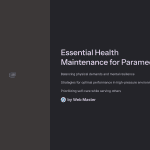 Working as a paramedic is more than just saving lives—it’s about enduring intense pressure, irregular hours, and emotional tolls that few people truly understand. With rising demands in emergency services globally and increasingly complex patient cases, the work environment for paramedics is undergoing critical transformations. According to recent studies in 2024, paramedics face elevated rates of burnout, PTSD, and injury compared to other healthcare roles. But there’s a silver lining—new policies and tech innovations are being introduced to ease workloads and improve safety. This post uncovers the gritty reality of paramedic work and offers insights into how future changes may create a more sustainable, rewarding career in emergency care.
Working as a paramedic is more than just saving lives—it’s about enduring intense pressure, irregular hours, and emotional tolls that few people truly understand. With rising demands in emergency services globally and increasingly complex patient cases, the work environment for paramedics is undergoing critical transformations. According to recent studies in 2024, paramedics face elevated rates of burnout, PTSD, and injury compared to other healthcare roles. But there’s a silver lining—new policies and tech innovations are being introduced to ease workloads and improve safety. This post uncovers the gritty reality of paramedic work and offers insights into how future changes may create a more sustainable, rewarding career in emergency care.

Long Hours, High Stress: The Double-Edged Sword of Saving Lives
Paramedics often work 12 to 24-hour shifts, responding to unpredictable calls that can range from mild to life-threatening. The very nature of the job means adrenaline spikes are frequent, rest is minimal, and breaks are rarely consistent. Most paramedics report chronic fatigue and irregular sleep patterns, which directly impact both their mental and physical well-being.
Despite the emotional satisfaction that comes from helping others, the stress can be overwhelming. Each call carries the weight of responsibility—your actions could mean the difference between life and death. Over time, this accumulates and contributes to mental health issues like anxiety, depression, and emotional exhaustion. Governments and agencies are now considering shift reforms and mandatory mental health support systems to reduce these burdens.

Safety Risks and Physical Hazards in the Field
Emergency scenes are often chaotic, dangerous, and unpredictable. From traffic accidents to fires, paramedics work amidst conditions that expose them to serious risks. In 2024 alone, reports from the International Labour Organization indicated an increase in on-duty injuries among paramedics due to insufficient protective equipment or lack of scene control.
Besides the obvious physical dangers, there’s also the long-term toll of lifting patients, carrying equipment, and performing strenuous procedures in tight spaces. Repetitive strain injuries and back problems are common. New ergonomic gear and AI-powered stretchers are being tested in select cities to reduce injury rates and improve safety on the job.

Emotional Burdens: The Hidden Weight Paramedics Carry
Beyond the visible chaos lies an emotional battlefield. Witnessing trauma, delivering bad news to families, or failing to revive a patient—these moments haunt many paramedics. Post-traumatic stress disorder (PTSD) and burnout are increasingly reported, yet still under-treated in the emergency care industry.
Organizations are finally beginning to prioritize mental wellness, integrating peer support programs, confidential counseling, and resilience training into their EMS departments. However, access and stigma remain significant barriers, particularly in rural areas or underfunded systems.

Understaffing and Systemic Pressure
One of the biggest issues in 2025 is the chronic understaffing in EMS departments. With fewer people entering the profession and higher rates of early retirement, paramedics are stretched thin, leading to longer response times and added pressure. This directly affects patient outcomes and staff morale.
To counteract this, many countries are pushing to improve recruitment through better compensation, career progression paths, and educational support. Incentive-based hiring and scholarships for EMS training are gaining popularity, but systemic change will take time.

Technological Innovations and the Future of EMS
Despite the hardships, technology is bringing new hope to the field. Wearable health monitors, AI-assisted dispatch systems, and drone-delivered defibrillators are just a few innovations reshaping paramedic operations. These tools not only improve patient care but also help reduce the cognitive load on paramedics.
Smart ambulances with real-time data syncing to hospitals allow for quicker diagnosis and preparation upon arrival. Meanwhile, remote guidance via augmented reality is being piloted for rural teams who may lack immediate specialist support.

Policy Shifts and Advocacy for Better Working Conditions
Policy reform is crucial to transforming the paramedic work environment. International EMS unions and advocacy groups are lobbying for legislated rest periods, hazard pay, and legal protections for paramedics. In places like Canada and the UK, new bills are being proposed to classify paramedics under separate labor categories to ensure rights tailored to their unique needs.
Public awareness campaigns are also contributing to cultural change. As more people understand the toll of the job, support for funding increases, and recognition for the profession grows. Advocacy isn’t just about improving work—it’s about securing better care for the people they serve
*Capturing unauthorized images is prohibited*






